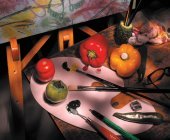|
Types of cameraThere are many types of camera, but the basic camera design is same since its invention. It is a lightproof box with a lens on one side and film holding device on the other side. In today's digital world, this film holder is replaced with a light sensitive digital image sensor. There is some kind of provision to preview the image and composition. This is done by a view finder. This premature design is improved with a shutter mechanism (in the lens or in the camera body) to allow the light to enter the camera for a specified time. An aperture or iris is provided to control the amount of light entering the camera. The distance between the lens and the film plane can be changed to focus the subject more precisely.
This basic form of design is further improved in five types of camera:
Range Finder or Compact camera EVIL Camera (read more about it)
Twin Lens Reflex - TLR
Single Lens Reflex -
SLR camera
and
DSLR camera
Range Finder or Compact Camera: These types of camera are a simple form of design, used in compact cameras. (even a mobile phone camera) Preview of an image is through seperate window. So it will give slight different picture of what you see. If you change the lens, you need to recalibrate the preview window. Use of any other optical attachment in front of the lens cannot be previewed. Yet, simplicity in design make these types of camera less expensive. Chances of mechanical failure is minimum. Read about how a range finder or compact camera works EVIL camera: EVIL stands for Electronic View Inter-changeable Lens. This is a design, with advantage of an SLR camera design, for accepting different focal length lenses, and simplicity in mechanics, similar to a range finder or a compact camera. Electronic technology has made this possible, and the design is accepted as a good option for entry level photographers. Twin Lens Reflex: There is a set of two identical lens in this design. Lower lens is taking lens which actually takes the picture and upper lens is viewing lens, which is for viewing and focusing the picture. This format of design is out dated now as it has same drawback as a range finder design. Only advantage is precision in focusing. Single Lens Reflex: (SLR or digital - DSLR)The basic requirement to see precisely what you are going to record on the film, led to the development of the single lens reflex camera. This is the design, adopted by many camera manufacturers for its unmatched features. These type of cameras are first choice for professionals and serious amateurs. The design is complicated, expensive and difficult to repair but offers a unique advantage - what you see is what you get. A mirror is placed at 45 degree between the lens and the image plane. This mirror reflects the preview of an image to the eyepiece. At this time, the aperture of the lens remains wide open for a bright view. When you press the shutter release button, the aperture closes down to pre-set value, mirror swings out of the path of light, shutter mechanism operates at pre-set time to expose the image, mirror drops back to its original position and aperture opens up back to its widest position. This whole sequence is done in fraction of a second. And that is the reason why the camera is complicated in design, bulky and expensive. SLR - DSLR offers unlimited choice of lens and other optical attachments, that can be used on the camera. You can use a tele lens or a wide angle lens, it will show the exact framing and if you put any filter on the lens, the effect of the filter also is visible.
Advantages: SLR - DSLR can be used with any focal length lens - from fisheye to extreme tele-lens Exact view is visible in view finder Through the lens exposure reading Depth of field can be previewed Effect of any optical attachment in front or behind the lens can be seen in the preview Disadvantages: Heavy, bulky and complicated mechanism Expensive and difficult to repair SLR makes noise at the time of click. So it will disturb timid subjects like birds View is blocked at the time of exposure Monorail or View Camera: This is the real tool for professionals. It is extremely simple in design. A lens board and a film or digital back is mounted on a rail. Bellows are provided between these two boards, to block the light. For a preview, you need to place a focusing screen in place of the film holder. Then you focus and compose that upside down image, replace the focusing screen with film and shoot. No need to say that the camera has to be mounted on a very sturdy tripod. This camera provides unlimited possibilities for different size of film (now different mega-pixel digital backs) and takes larger size of digital-backs. So even for modern time, it can take some 39 or 75 mega-pixel back and give unmatched picture quality, and that is not the limit. In addition, this design allows to swing, tilt or shift the lens board and/or the film board. These moments are the key factor in increasing depth of field and correcting perspective of an image. So there is no comparison for this design with any other types of camera design.
Return back to Camera from types of camera
Auto focus mechanism of camera
Other photographic accessories
|






